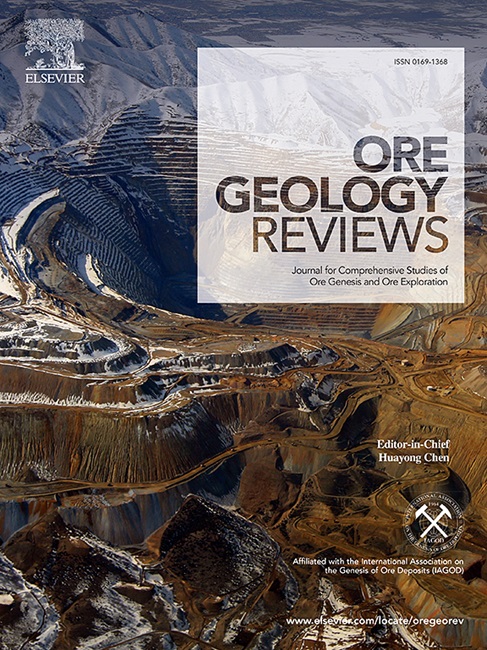Role of mantle material in the formation of Sn mineralization – Noble gas constraints from the giant Jiepailing Sn-Be-F deposit, Nanling region, South China
IF 3.2
2区 地球科学
Q1 GEOLOGY
引用次数: 0
Abstract
The Nanling region hosts a major W-Sn ore belt with numerous Late Triassic and Late Jurassic W-Sn deposits that are the final product of crustal melting due to crustal extension and upwelling of mantle material. Less well-known are Late Cretaceous Sn-polymetallic deposits within the Nanling region and their sources. Here, we present U-Pb cassiterite ages and systematic S-Pb-He-Ar isotope data of sulfides from the giant Jiepailing Sn-Be-F deposit. In situ LA-ICP-MS U-Pb dating of cassiterite yields an intercept age of 90.8 ± 0.9 Ma. The Pb isotopic compositions of pyrite (206Pb/204Pb = 18.54–18.75; 207Pb/204Pb = 15.68–15.71; 208Pb/204Pb = 38.84–38.96) are typical for ancient upper crustal rocks. Pyrite and chalcopyrite have overlapping ranges of δ34S values (2.9 ‰–6.2 ‰) that imply S was mainly derived from a magmatic fluid. Fluid inclusions in pyrite have 4He and 40Ar concentrations of 0.6 to 3.1 (10-7 cm3 STP/g) and 2.1 to 5.1 (10-8 cm3 STP/g), respectively, with corresponding 3He/4He ratios of 4.0 to 5.7 Ra (where Ra is the 3He/4He ratio of air = 1.39 × 10-6) and 40Ar/36Ar ratios of 359.6 to 530.2. The noble gases in the fluid inclusions have a mixed origin from the crust and the mantle, with c. 54 to 75 % He and less than 1 % Ar derived from the mantle. We interpret the mixed geochemical signature to imply that mantle melts provided heat and fluids (and noble gases) for melting of crustal sources that eventually formed the Jiepailing Sn-Be-F deposit. The higher apparent contribution of mantle He reflects that the crustal melt source had very little He, but considerable amounts of Ar. The regional distribution of c. 80–90 Ma old intrusions and Sn mineral deposits in a 1500 km long belt from the Ailao Shan Fault and the Youjiang Basin to the Nanling region implies that the heat source for crustal melting were made available by large scale tectonic processes, including the reactivation of old crustal-scale faults, during the collision of the Gangdese arc and the lithospheric extension above the Paleo-Pacific plate.

地幔物质在锡矿化形成中的作用——南岭界坪大型锡be - f矿床稀有气体约束条件
南岭地区是一个主要的钨锡矿带,有大量晚三叠世和晚侏罗世的钨锡矿床,这些矿床是地壳伸展和地幔物质上涌作用下地壳熔融的最终产物。南岭地区晚白垩世锡多金属矿床及其来源鲜为人知。本文给出了介白岭大型锡be - f矿床硫化物的U-Pb锡石年龄和系统S-Pb-He-Ar同位素数据。锡石原位LA-ICP-MS U-Pb测年得到的截距年龄为90.8±0.9 Ma。黄铁矿Pb同位素组成(206Pb/204Pb = 18.54 ~ 18.75;207Pb/204Pb = 15.68-15.71;208Pb/204Pb = 38.84 ~ 38.96)是古代上地壳岩石的典型特征。黄铁矿与黄铜矿δ34S值范围(2.9‰~ 6.2‰)重叠,表明S主要来源于岩浆流体。黄铁矿流体包裹体中4He和40Ar的浓度分别为0.6 ~ 3.1 (10-7 cm3 STP/g)和2.1 ~ 5.1 (10-8 cm3 STP/g),对应的3He/4He比值为4.0 ~ 5.7 Ra(其中Ra为空气中的3He/4He比值= 1.39 × 10-6), 40Ar/36Ar比值为359.6 ~ 530.2。流体包裹体中的稀有气体混合来源于地壳和地幔,其中约54 ~ 75%的He和不到1%的Ar来自地幔。我们对混合地球化学特征的解释表明,地幔熔体为地壳源的熔化提供了热量和流体(和稀有气体),最终形成了介岭锡-铍- f矿床。地幔He的高贡献反映了地壳熔融源中He的含量很少,而Ar的含量相当大。从牢山断裂和右江盆地到南岭地区1500 km长的区域内,c. 80-90 Ma的老侵入体和锡矿床的区域分布表明,大范围的构造作用为地壳熔融提供了热源,包括旧地壳尺度断裂的再活化;在冈底斯弧和古太平洋板块上方岩石圈伸展的碰撞期间。
本文章由计算机程序翻译,如有差异,请以英文原文为准。
求助全文
约1分钟内获得全文
求助全文
来源期刊

Ore Geology Reviews
地学-地质学
CiteScore
6.50
自引率
27.30%
发文量
546
审稿时长
22.9 weeks
期刊介绍:
Ore Geology Reviews aims to familiarize all earth scientists with recent advances in a number of interconnected disciplines related to the study of, and search for, ore deposits. The reviews range from brief to longer contributions, but the journal preferentially publishes manuscripts that fill the niche between the commonly shorter journal articles and the comprehensive book coverages, and thus has a special appeal to many authors and readers.
 求助内容:
求助内容: 应助结果提醒方式:
应助结果提醒方式:


